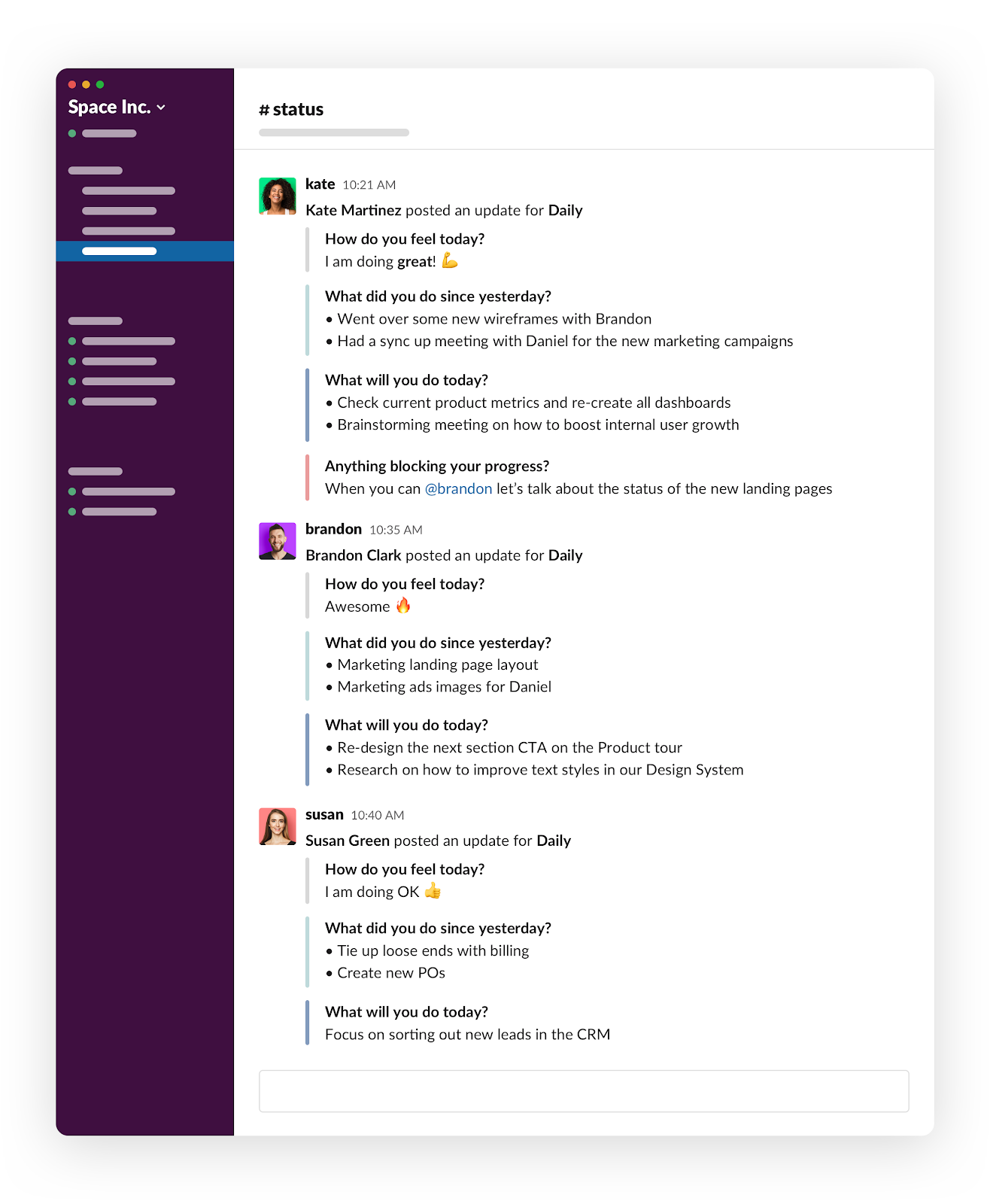Traditional in-person standup or scrum meetings are a source of frustration for many of our customers, and they were for us too before we started Geekbot. These daily meetings, which are particularly popular among Agile software development teams, are supposed to keep everyone on the same page, allow an opportunity for status updates, promote collaboration, and improve work quality. But they often end up being resented by team members because they’re long, interruptive, and mostly not relevant to their day-to-day work.
For example, team members might arrive at work at 8 a.m. and have to attend a daily standup or scrum meeting at 10 a.m., right when they’re making progress on a project or tackling their to-do list. Once there, they have to listen to their co-workers and managers discuss decisions that they don’t need to be present for and projects that are unrelated to their work. They often spend over an hour in these meetings where they may only speak for two minutes.
For introverted employees, standup meetings are even worse. Not only are they long, boring and largely irrelevant, but they’re also terrifying. Not everyone is comfortable speaking in front of their whole team, including many people on software development and IT teams. In fact, we’ve heard from more than one developer who has admitted to trying to “hide in the shadows” during daily scrum meetings so they could skip their turn.
Anyone who’s noticed the obvious downfalls of standup meetings is left to wonder if there’s an effective way to replace them. And we’re happy to report there are several. We’ve identified four ways to replace daily, in-person standup meetings, including a way to automate them using our Slackbot Geekbot.
If you’d like to replace in-person standup meetings with a quicker, more effective Slack-based alternative, learn more and sign up to try Geekbot here.
Replace Daily Standup Meetings with Less Frequent Meetings and More Casual Interactions That Fulfill the Same Functions
Standups serve three important functions. They serve a (1) reporting function by allowing the entire team to update one another on their work. They serve a (2) bonding function by encouraging team members to connect with each other daily. And they serve a (3) planning and unblocking function by allowing managers to strategize for the future and remove any barriers that exist for their team.
If you can fulfill these functions in other ways, then daily standups become unnecessary. Here are a few suggestions for fulfilling these functions without a daily standup:
- You can fulfill the reporting function by meeting once a week, once every two weeks or once a month to update each other on work progress.
- You can fulfill the bonding function by encouraging team members to greet each other casually every day. One of our customers fulfilled this function by asking team members to say “hi” in the kitchen every morning.
- You can fulfill the planning and unblocking function by scheduling regular decision-making meetings for management. Dedicated decision-making meetings not only prevent team members from having to listen to discussions about decisions that aren’t relevant to them, they perform an unblocking function, since unmade decisions are one of the biggest blockers. These meetings don’t need to happen daily, but they should be scheduled frequently enough that managers aren’t sitting on decisions that are holding team members back.
Use Your Project Management Tool as a Replacement for Standup Meetings by Keeping It Meticulously Updated
Almost all of our customers use a tool like Trello or Asana to manage projects. These tools are designed to be “update centers” where everyone involved in a project can communicate with one another and keep each other informed on their progress. So, technically, these tools already act as an asynchronous communication hub. Unfortunately, not everyone participates consistently and project management boards can quickly become out-of-date. One of our employees here at Geekbot, for example, used to manage the IT department at a university. He tried this approach with his team, but he found that project management boards became obsolete in just three to four weeks.
If you can motivate team members to stay on top of updates, this approach may still be worth a try. The promise of not having a team meeting may be all the motivation some team members need. However, it might be wise to have a system for notifying or reminding team members to update the project management tool daily.
Have a Video Call Meeting
With the increasing number of remote workers, in-person standup meetings have become more difficult to schedule. That’s why video call meetings could be an effective standup alternative.
Conducting video calls via Zoom or Slack while a facilitator or scrum master takes notes in a Google Doc is more convenient than in-person standups. This way attendees can stay at their desks (whether those desks are in a shared office, at home, or in a co-working space).
Keep in mind, there are some downsides to video call meetings. Team members still have to disrupt their work to attend. And these meetings can still run long — anywhere from 30 minutes to an hour — when a lot of team members are involved.
The Alternative We Built and Use Every Day — Automate Standup Meetings in Slack with Geekbot
Geekbot is a slackbot that helps you set up asynchronous online standup meetings in Slack. When it’s meeting time, Geekbot sends a direct message to employees asking about their work in progress. It posts the answers in the broadcast channel for everyone to see.

There are a lot of obvious benefits to this approach, the biggest being that it saves time and disrupts the work day less by allowing everyone to stay at their desk, type their updates, and move on — whenever it’s convenient for them.
In fact, it’s one of the only alternatives that addresses all the most glaring downsides of standup meetings — time, relevancy, and team member comfort. But those aren’t the only benefits to replacing in-person standups with Geekbot in Slack. Here are a few others:
- Since everyone’s updates go into a public channel, you can always see what others are working on, but you have the freedom to skim past updates that aren’t relevant to you.
- Slack allows you to have side discussions using threads, so you can go deep into topics with relevant team members without bombarding other team members with information that isn’t useful to them.
- If you need help from specific team members to surface blockers, you can tag them to get their attention.
- Geekbot encourages team bonding by allowing you to ask questions like, “How do you feel?” or “What did you do this weekend?” in Slack daily standups and retrospectives.
- Remote teams can fulfill the function of a standup meeting without coordinating for different time zones and hopping on video calls at odd hours.
- In Slack, you have a written history of every update that’s searchable; you can easily search for specific projects or people. Plus, on Geekbot’s dashboard, you can filter your existing standups by date range, participants, and questions, making it even easier to find the information you’re looking for.
You should also know that Geekbot can help with more than just standups. In addition to its daily standup preset, Geekbot has presets for:
- Team retrospectives where team members can give their feedback on how a project went.
- Sales reports that track team performance and report on sales goals.
- Team feedback that lets team members know how they’re doing.
- Meeting notes that summarize meetings.
- A mistake log that documents mistakes, so they aren’t repeated.
- Fun questions (known as Pizza Toppings) that help team members relax and bond.
- Sharing the day’s lessons to inspire others.
- A product changelog to track changes in product development.
(Want to learn more about what Geekbot can do for your team? Check out our features page.)
All that said, we know many managers want their teams to have some face-to-face interaction, especially when that team is co-located in one office space. If that’s the case, you can do what some of our other customers do. You can schedule an in-person meeting, ask team members to enter their updates in Slack using Geekbot beforehand, and then briefly cover those updates at the in-person meeting. This is a good way to reduce the amount of time team members are required to speak in front of the group and keep meetings short. You can see everyone face-to-face, address what needs to be addressed, and then move on with the day.
If you’d like to replace in-person standups with a quicker, more effective alternative, sign up for a free Geekbot trial.
Frequently asked questions
What happens in daily standup meeting?
During a daily standup meeting team members take turns to answer three specific questions on what they completed since the last standup meeting, what are they planning to complete next, and if there are any roadblocks preventing them from doing their work. Daily stand up meetings keep teams aligned around their goal and quickly identify any issues that affect their progress.
What are the benefits of daily standup meeting in agile?
The common benefits of a daily standup meeting in agile are: team alignment, robust team communication, flexible and fail-safe product development, high team morale, improved team collaboration, and knowledge sharing. Effective stand up meetings have a proven track of increasing team productivity and focus for both short-term project goals and long-term company projects.
How do I start a Scrum standup meeting?
A scrum standup meeting starts when all team members and Scrum Master meet in the same room, stand up, and take turns in asking three specifically designed questions. The main goal is to keep the meeting short and let every team member provide quick and sharp feedback on the work they are doing. Standup meetings can also be remote and are typically conducted by using online messaging and conferencing tools.



